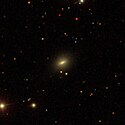IC 2426
| Galaxie IC 2426 | |
|---|---|
 | |
| SDSS-Aufnahme | |
| AladinLite | |
| Sternbild | Wasserschlange |
| Position Äquinoktium: J2000.0, Epoche: J2000.0 | |
| Rektaszension | 08h 58m 30,5s[1] |
| Deklination | +02° 55′ 32″[1] |
| Erscheinungsbild | |
| Morphologischer Typ | S0[1] |
| Helligkeit (visuell) | 14,7 mag[2] |
| Helligkeit (B-Band) | 15,5 mag[2] |
| Winkelausdehnung | 0,4′ × 0,2′[2] |
| Positionswinkel | 111°[2] |
| Flächenhelligkeit | 11,8 mag/arcmin²[2] |
| Physikalische Daten | |
| Rotverschiebung | 0.013023 ± 0.000158[1] |
| Radialgeschwindigkeit | (3904 ± 47) km/s[1] |
| Hubbledistanz vrad / H0 | (168 ± 12) · 106 Lj (51,5 ± 3,7) Mpc [1] |
| Geschichte | |
| Entdeckung | Stéphane Javelle |
| Entdeckungsdatum | 23. März 1900 |
| Katalogbezeichnungen | |
| IC 2426 • PGC 25208 • CGCG 033-033 • MCG +01-23-014 • 2MASX J08583049+0255314 • GALEXASC J085830.58+025530.8 | |
IC 2426 ist eine linsenförmige Zwerggalaxie vom Hubble-Typ S0 im Sternbild Hydra südlich der Ekliptik. Sie ist schätzungsweise 168 Millionen Lichtjahre von der Milchstraße entfernt und hat einen Durchmesser von etwa 20.000 Lj.
Im selben Himmelsareal befinden sich u. a. die Galaxien NGC 2713, NGC 2716, NGC 2723.
Das Objekt wurde am 23. März 1900 von Stéphane Javelle entdeckt.[3]
Weblinks
Einzelnachweise
Auf dieser Seite verwendete Medien
Autor/Urheber: Sloan Digital Sky Survey, Lizenz: CC BY 4.0
The sky image is obtained by Sloan Digital Sky Survey, DR14 with SciServer.
Angle of view: 4' × 4' (0.3" per pixel), north is up.
Details on the image processing pipeline: https://www.sdss.org/dr14/imaging/jpg-images-on-skyserver/



